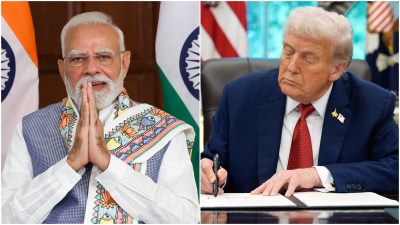Now playing in Ramallah
In the week in which hope was the VVIP passenger on a long-awaited bus between two countries, the faint intimations of a border-crossing in ...

In the week in which hope was the VVIP passenger on a long-awaited bus between two countries, the faint intimations of a border-crossing in the West Bank nearly went unnoticed. Richard Attenborough’s Gandhi was screened in Ramallah last Wednesday, for the first time since its release more than two decades ago, and for the first time dubbed in Arabic.
It didn’t happen by popular demand, of course. The film’s screenings are the centrepiece of the ‘‘Gandhi Project’’ that is financed by wealthy American businessmen and that plans to take the film, without charge, to Palestinian communities throughout the West Bank and the Gaza Strip, in cities, refugee camps and villages. Ben Kingsley was flown down to Ramallah for the staged event as the guest of Palestinian PM Mahmoud Abbas.
But perhaps Gandhi’s story let loose an unscripted frisson in the audience of 300 gathered in the Palace of Culture on Wednesday.
‘‘I wanted to see how he confronted occupation,’’ Abla Afanah, teacher, told the New York Times at the screening, ‘‘I think it may be possible to implement this here’’. Her friend disagreed: ‘‘Gandhi would fail if he faced the Israelis’’.
‘‘There are too many differences. If we stopped resisting Israel, it would probably confiscate all the land left to us,’’ the Guardian quoted 21-year-old Dea Opahi after she watched the film.
People in charge
Words simply had to yield to the images. British and American papers described how people in Muzaffarabad climbed on the ledges of buildings to wave at the coach with tinted windows on its way to India. The mobs in Srinagar, so thick the bus could barely pass. The passenger kneeling to kiss the asphalt. The billboard in Pakistan, or was it in India, that read: ‘‘From Home to Home’’. Soldiers from both sides smiling and shaking hands in an area where the two armies were relentlessly pounding each other with artillery less than two years ago.
It took the resolutely dry-eyed to ask whether the symbolism of the crossing would continue to outweigh its impact on the ground. Financial Times’s Foreign Editor Bronwen Maddox, for one, wondered about that.
The world must not allow itself to be reassured just yet, wrote Maddox. Please note the absence of both President Musharraf and PM Shaukat Aziz from the bus celebrations; the fact that ‘‘there is not even a road map for talking about the future of Kashmir’’; the ‘‘strained and fragile’’ coalition Manmohan Singh leads, ‘‘preoccupied with turbulent provincial elections’’; Musharraf’s constant leveraging of his vulnerability to extract concessions from the US while doing little to improve his legitimacy.
Having said that, Maddox succumbed too. ‘‘One hope of yesterday’s events is that practical reality takes over, and the two divided communities of Kashmir re-knit their ties so firmly that they drag the politics behind them.’’
The big story
Everyone’s talking India and China. Or India versus China. The big story of our time tracks the global power shift to Asia in a backdrop of dissolving Cold War arrangements.
In the week Wen Jiabao made his way to India, Time predicted that meetings between leaders of China and India will soon be monitored not just in the region, but by the whole world. For, Asia’s story is changing dramatically. It’s no longer all about economics, ‘‘…now geopolitics are starting to define the Asian story, and Washington has woken up to the fact that China is not the only Asian power that is rising’’.
The Guardian pointed to Condoleezza Rice’s recent New Delhi visit bearing the Bush administration’s offer to ‘‘help India become a major power in the 21st century’’ as proof that America is hard at work on Asia’s upheaval. Because ‘‘…it offers hitherto unrealised opportunities… to determine the future of the world’’.
South Asia correspondent Randeep Ramesh saw in the US’s efforts to woo India ‘‘an exact reversal of its triangular diplomacy of 30 years ago’’. He wrote: ‘‘What America wants to do to China in the early years of this millenium appears similar to what it did to Russia in the last decades of the previous century. On offer to India is an opening—as well as a means to reduce China’s influence—by joining Washington to challenge Beijing’’. The question for India now, as it was for China in the early 1970s, is: Will it be America’s tool or ally?
For the FT, quite simply, it’s ‘‘India’s turn in the diplomatic limelight’’ in a world that has inexorably left the past behind. Wooed by Beijing and by Washington, ‘‘the likelihood that India will get its way shows how quickly we have moved from the two-sided Cold War and the subsequent dominance of a single US superpower to the beginnings of a truly multipolar world’’.
This story has a great future.





- 01
- 02
- 03
- 04
- 05

























